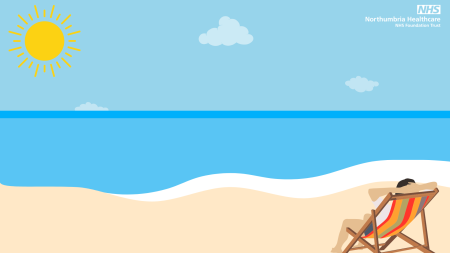Publish date: 9 June 2023
Staying safe in the sun

Getting sunburned raises your chances of getting skin cancer. It's not just a holiday thing – you can get burned in the UK, even on cloudy days.
There's no safe or healthy way to get a tan. A tan doesn't shield your skin from the harmful effects of the sun.
Try to find a balance between keeping yourself safe from the sun and getting enough vitamin D from sunlight.
Sun safety tips
When the sun is very strong, try to stay in the shade. In the UK, this is from 11am to 3pm between March and October.
Remember to:
- Stay in the shade between 11am and 3pm.
- Never let yourself get burned.
- Wear appropriate clothing and sunglasses to cover up.
- Be extra careful with children.
- Use sunscreen with a protection factor of at least 30.
What factor sunscreen (SPF) should I use?
Remember, sunscreen alone is not enough to keep you safe from the sun. Wear the right clothes and find shade when the sun is strongest.
When you buy sunscreen, check that it has:
- An SPF of at least 30 to protect against UVB.
- At least 4 stars for UVA protection.
- Look for the letters "UVA" in a circle, which means it meets the EU standard.
Also, make sure the sunscreen is not expired.
Remember, don't stay in the sun longer just because you're wearing sunscreen.
What are the SPF and star rating?
The sun protection factor (SPF) tells you how much protection a sunscreen provides against harmful UVB rays from the sun.
SPFs range from 2 to 50+ to show the level of protection. Higher numbers like 50+ mean stronger UVB protection.
The star rating shows how well a sunscreen shields you from UVA rays. In the UK, you'll find sunscreens with up to 5 stars. The more stars, the better the protection.
If you see the letters "UVA" inside a circle, it means the sunscreen meets European standards and has UVA protection that's at least a third of the SPF value.
Sunscreens that guard against both UVA and UVB rays are often called broad spectrum.
How to apply sunscreen
Many people don't use enough sunscreen, which can make it less effective.
To give you an idea, adults should try to use about 6 to 8 teaspoons of sunscreen to cover their whole body.
If you put on too little sunscreen, it won't protect you as well.
If you're worried about not using enough SPF30 sunscreen, you could use a higher SPF.
If you're going to be in the sun for a while and might get burned, you should apply sunscreen two times:
- 30 minutes before going outside
- Just before going outside
Remember to put sunscreen on all the exposed areas of your skin, including your face, neck, ears, and head if you have thin hair. But wearing a wide-brimmed hat is even better.
You need to reapply sunscreen often and generously, following the instructions on the bottle.
This includes putting more on right after you've been in the water, even if it says it's "water resistant," and after drying off with a towel, sweating, or if it might have rubbed off.
It's also a good idea to reapply sunscreen every 2 hours because the sun can make it dry up on your skin.
Swimming and sunscreen
Water can wash off sunscreen, and when you're in the water, it might feel like you're not getting sunburned because it cools your skin. But water can also reflect UV rays and make you more exposed to the sun.
If you think you might sweat or get wet, it's a good idea to use water-resistant sunscreen.
After you've been in the water, even if the sunscreen says it's "water resistant," and after you've dried off with a towel, sweated a lot, or if the sunscreen might have rubbed off, remember to put more sunscreen on again.
Children and sun protection
It's important to be extra careful in protecting babies and children. Their skin is more delicate than adults' skin, and getting too much sun when they're young can increase the risk of skin cancer later in life.
Babies under 6 months old should be kept away from direct strong sunlight.
Between March and October in the UK, children should:
- Wear appropriate clothes that cover their skin.
- Spend time in the shade, especially from 11am to 3pm when the sun is strongest.
- Use sunscreen with at least SPF30.
- Put sunscreen on areas that are not covered by clothing, like the face, ears, feet, and backs of hands.
Protect your eyes in the sun
If you don't protect your eyes in the sun, they can get hurt, just like when your skin gets sunburned.
Light reflecting off things like snow, sand, concrete, water, and even artificial light from sunbeds can be really harmful to your eyes.
Don't look directly at the sun because it can cause lasting damage to your eyes.
Clothing and sunglasses
When you're outside, wear clothes and sunglasses that protect you from the sun, like:
- A hat with a wide brim that covers your face, neck, and ears.
- A shirt with long sleeves.
- Trousers or long skirts made of tight-woven fabric that doesn't let sunlight through.
- Sunglasses with lenses that wrap around or wide arms, and look for the CE Mark and British Standard Mark 12312-1:2013 E.
How to deal with sunburn
If your skin is sore from sunburn, gently pat it with cool water and then put on a soothing aftersun cream or spray, like aloe vera.
Taking painkillers like paracetamol or ibuprofen can help with the pain by reducing the swelling caused by sunburn.
Make sure to avoid the sun until your skin is no longer red.
If you feel sick or your skin swells a lot or gets blisters, it's important to get medical help.
Stay out of the sun until your skin is no longer red.
Who should take extra care in the sun?
If you:
- Have light-coloured skin, pale, white, or light brown
- Have freckles or red or fair hair
- Easily get sunburned instead of getting a tan
- Have lots of moles
- Have skin problems because of a medical condition
- Only spend a short time in strong sun occasionally, like on holiday
- Live in a hot place where the sun is really strong
- Have family members who had skin cancer
You need to be extra careful when you're in the sun. People who spend a lot of time outside, whether for work or fun, have a higher chance of getting skin cancer if they don't protect themselves.
If you have naturally brown or black skin, you have some protection against UV rays, so you're less likely to get skin cancer. But even so, you should still be careful in the sun and avoid getting sunburned. People of all skin colours can get skin cancer.
Pay attention to your skin and look for any changes.
Here are the changes you should watch out for:
- A new mole, growth, or lump
- Moles, freckles, or patches of skin that change in size, shape, or colour
Tell your doctor right away if you notice any of these changes. Skin cancer is much easier to treat if it's found early.
